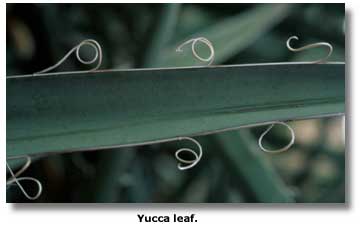Datil Yucca
Yucca baccata - Agave Family - Agavaceae
The datil yucca is also called the banana yucca, Spanish bayonet, Spanish dagger or amole. Yucca (yuck-ka) is a Caribbean name for the cassava plant, which originally was named Yucca gloriosa. Baccata means "fruited," referring to the plant’s large fruits. The name banana yucca also refers to the large fruits. In wet years, when many yuccas bloom over the landscape, they resemble large snowy-white candles; hence, the plants may be called by yet another name, "Our Lord's candles." Unlike agaves, with which yuccas are often confused, yuccas bloom each year (more or less), while agaves bloom only once.

Description
The datil yucca has large, stout straplike leaves which are twelve inches to forty inches long, one inch to two inches wide, and are sharply pointed. The plant has very short stems, which may occur singly or clumped together. Leaves are arranged spirally at the base of the stem. Individual white fibers along the leaf margins tend to curl. The flowering stalks may barely rise above the leaves. Bell-shaped flowers, which grow in thick clusters during the spring, are one and one half inches to three and one half inches long and are creamy white in color. Each flower has six perianth segments and three stigmas on a stout pistil. The fruits are large, four inches to nine inches long, and fleshy at maturity. The pods contain flat, blackish seeds.
Range and Habitat
The datil yucca occurs in California, Nevada, Arizona, Colorado, New Mexico, Texas, Utah and Mexico. It grows in pinyon-juniper, sagebrush, mountain brush and ponderosa pine communities from four thousand seven hundred and twenty five feet to six thousand six hundred and twenty feet in elevation.
Plant Uses
The Pueblo Indians of the American Southwest utilized the datil yucca for food as well as utilitarian products. The fleshy fruits were eaten green or dried and stored for winter consumption. Baked, the fruit has a flavor which is reportedly similar to potatoes. In some pueblos, the datil pulp was mixed with berries and made into cakes that could be dried for winter use. The young flower stalks were also eaten, like asparagus.

From the yucca leaf came fibers that were either twisted or plaited together to make cordage. Leaves were soaked in water, then pounded with stones to separate the long fibers. Sometimes human or animal hair or even bird plumage was added to the strands, which were twisted into string or ropes. These were used for belts, rope ladders, sandal toe straps, cradle board ties, fishnets and sandals. The fibers were also used for mats and clothing and were incorporated into baskets. Bundles of prepared yucca leaves, called "quids," have been found in prehistoric structures.
The leaves were also utilized as paintbrushes by the Southwest Indians. Women chewed the leaf tip to a fine fringe which created an excellent paintbrush to use in decorating pottery.
 From the roots comes shampoo, which has been used both prehistorically and historically. The dry roots were pounded by the Indians then whisked into cold water to create suds. The saponin-rich roots create a soaplike lather which can be used in cleaning. The suds were used to wash the hair in both personal and spiritual cleansing. The white frothy suds reminded Native Americans of the large summer thunderstorms which cleansed the landscape with their rain showers, thus, datil yucca suds represented a spiritual cleansing of the person.
From the roots comes shampoo, which has been used both prehistorically and historically. The dry roots were pounded by the Indians then whisked into cold water to create suds. The saponin-rich roots create a soaplike lather which can be used in cleaning. The suds were used to wash the hair in both personal and spiritual cleansing. The white frothy suds reminded Native Americans of the large summer thunderstorms which cleansed the landscape with their rain showers, thus, datil yucca suds represented a spiritual cleansing of the person.
In more recent times, Yucca-Dew Shampoo was a commercial product that utilized the sudsing agent of a yucca plant. Shasta Rootbeer contains yucca on its list of ingredients; the yucca ingredient creates the soda's white, foamy head.
The woodrat or packrat chews through the base of the leaves to separate them from the plant. The rodent then takes the leaves back to its burrow and arranges them on the outer portion of its "conglomerate" nest, which is made up of twigs, cactus pads, animal droppings and shiny human objects like spoons or coins. Occasionally, deer nip off the developing stalks from the plant and eat them.
The nocturnal yucca, or pronuba, moth has a special relationship with the yucca, so special, in fact, that there is a specific pollinating moth species for each yucca species. The moth rolls pollen into a small ball and transfers it from plant to plant. While pollinating the flower, the female lays her eggs in the plant's ovary. The growing larvae feed upon the developing fruit. When the larvae is ready to pupate, it leaves the pod and crawls down the stem and burrows into the ground.
Click here to read about the yucca moth.
Interesting Facts About Yucca Plants . . .
- Yucca wood has the lowest ignition temperature of any other wood, which makes it useful as a fire-starter.
- The state flower of New Mexico is the "yucca flower."
- Yucca plants are reliant on the yucca moth for pollination.
Related DesertUSA Pages
- How to Turn Your Smartphone into a Survival Tool
- 26 Tips for Surviving in the Desert
- Death by GPS
- 7 Smartphone Apps to Improve Your Camping Experience
- Maps Parks and More
- Desert Survival Skills
- How to Keep Ice Cold in the Desert
- Desert Rocks, Minerals & Geology Index
- Preparing an Emergency Survival Kit
Share this page on Facebook:
The Desert Environment
The North American Deserts
Desert Geological Terms



